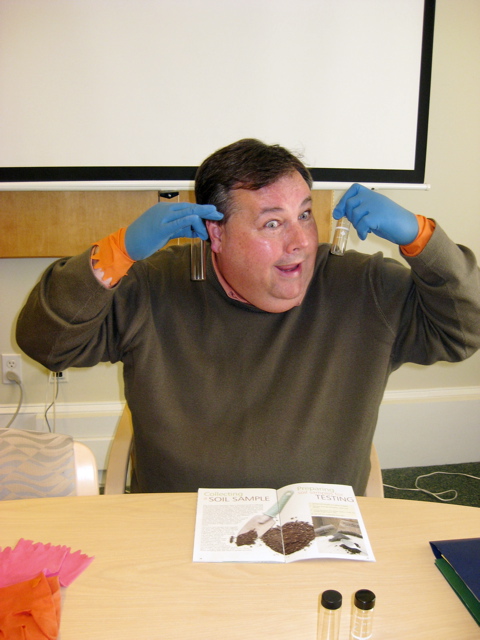
Photos courtesy of www.dirtdiva.com
"I'm really mystified by homeowners who will plop down $30,000 dollars to a landscape designer who will come up with a plant palette without ever thinking to take a spoonful of soil to test first," says Professor Stephen Andrews, aka the dirt dude, soil scientist at UC Berkeley. "One of the criteria for selecting a landscape architect is to give them a soil quiz! Ask them what kind of soil test they'll be providing. Be an informed consumer." Fall and spring are the best times to do your own backyard soil quiz, especially if you've just moved into a home and acquired a new plot of land.
Here are some preliminary questions to ask yourself (and anyone else remotely interested) about your soil:
- Is the soil worked easily?
- Is the soil full of living organisms?
- Are earthworms and other creepy-crawlers abundant in the soil?
- Is water available for plant growth?
- Are there air pockets in the dirt?
- Does my garden make ME look good?
After you're done hating your compacted soil and admiring yourself in front of the mirror in your new garden hat, it's time to get scientific. Why? Because us compost-spinning-tree-huggers believe all home gardeners who are cultivating a small or huge plot of land have been handed a gift from Mother Nature and can easily become superb stewards of that land.
"If you're going to do any type of landscaping project, make sure to test your soil first to understand what kind of a baseline you have. There are a few different routes," says Andrews. "If you're changing a large backyard area, doing drainage work or you've just purchased a new home, go get a 'commercial' soil test done. It may cost you a few hundred dollars but you'll have a thorough analysis and interpretation of your land. The testing company will also give you specific advice on how to proceed."
For the rest of us, who don't have the green to spend right now, on the brown, it's perfectly fine to take the mom & pop route. Head on down to your local plant nursery to purchase a home garden test kit. A good soil test will run about $20.00. "I like Mosser Lee's " Soil Master" kit because of the educational information included. It's also a simple test. It's color-coated and it's idiot-proof, I promise. Do it with the kids or grandkids," recommends Andrews. "Or, get the entire neighborhood and have a soil testing Bar-b-que! One test kit will have enough tubes to do 10 soil tests. You may be the diva who does everything organic, but next door you're living next to Charlie Chevron who uses every petrochemical on the planet! Get together and literally talk dirt."
With the home soil test, you'll be testing your soil's pH. The pH level will tell you if your soil has the proper levels for nutrient uptake or if you're just out there over-fertilizing, polluting and wasting your hard earned cash on garden products. "The ideal pH is 6.5. The reason we want it to be slightly acidic is because the plant nutrients are carried in a solution. If it's slightly acidic, the nutrients can dissolve and can be transported," says Andrews. "If the pH is too alkaline, the nutrients will sit there like lead balls of pasta, not going anywhere. By having it slightly acidic you have the best pH for nutrient uptake."
To lower the pH, you can use coffee grounds, teabags or sulfur or aged animal manure. To raise the pH, add Limestone or oyster or egg shells.
Being a compost groupie, I like to add a thin layer of compost on top of any soil amendments, as well. Or, if this is all too much for you because you're not a nature freak or you don't have time to worry about your soil's pH, simply add compost! Compost is full of nutrients that your plants with take in slowly over time. A nice 2-3 inch layer on top of your soil twice a year should keep your garden smiling.
You'll also be testing for the availability of your soil's macronutrients; nitrogen (N), phosphorus (P) and potassium (K). These are the main nutrients and minerals needed by your plants. You'll see the letters NPK on fertilizer containers. Once you know which nutrients are already hanging out in your soil, you won't be wasting money on unnecessary products.
When collecting your home soil sample, choose a few different sections of your yard. For instance, your edible garden in raised beds would be one test area while your front lawn or a slope or a woody area would each be a separate area to test. "For each chosen area, do a representative sampling. Pick ten to fifteen different spots in that area and dig down 6-8 inches," recommends Andrews. "Remove critters, rocks, roots and plant material. You just want soil parts. Take all samples from that area and mix them into a plastic baggie. Label the bag and the area accordingly. For a lawn, dig down only 2-3 inches. God help you if you're growing a lawn in droughty California!"
If you've decided to do the' commercial' test, you'll be mailing in your sample to the company. Contact them and decide just how comprehensive a test you'd like to do. Andrews suggests testing for pH nutrient availability, particle size analysis, bulk density, moisture content, organic matter content, macro and micro nutrients and soluble salts. If you live in an urban area and are growing edibles or in an older home where lead contamination has been commonly found from paint, 'heavy metals' testing should be done as well.
'Commercial' soil testing should be done when you first move into a home or every ten years or so, depending on your budget and your gardening success or utter failure. The 'home' soil test would be useful to do any time a considerable amount of plants in your yard look beaten down, chewed up, stagnant or like they've been smoking too much crack. Do a soil test (and tell them to make new friends). Testing your soil twice a year; once in the spring and again in the fall, is especially helpful if you're growing fruits and vegetables year round. "Cold season crops have different needs than warm season crops. Like us, our underground soil friends slow down when it's colder outside," says Andrews. "The bacteria slow down but once the soil warms up, the disco lights come on and they're ready to party! "

(Professor Stephen Andrews: See! Soil science can be FUN.)
Last, if you haven't been adding a 1-3 inch layer of compost to your yard or side-dressing your plants with it once or twice a year, get to it now. Compost is key to any successful garden. It slowly adds nutrients to your soil while holding in moisture so you're watering less frequently. Get off the synthetic fertilizer and pesticide cycle. That's so old school! Those chemicals destroy the good microbes, beneficial insects and earthworms living in the compost who are working 24/7 breaking down organic matter, to make your yard look fabulous!
For more on dirt, come nerd it up with me at www.dirtdiva.com

